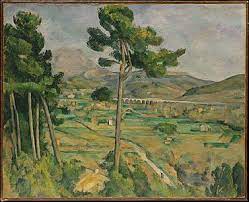Paul Cézanne is one of the most important painters in contemporary art history and has influenced many other artists. His singular technique for creating a shape with color and his analytical view of nature, often characterized as Post-Impressionist, impacted the work of Fauves, Cubists, and later generations of avant-garde painters.
Cézanne started painting in 1860 in his hometown of Aix-en-Provence and then studied in Paris. His early works, which include romantic and classical subjects, are characterized by dark hues and expressive brushwork in the manner of Eugène Delacroix.
The vigor with which Cézanne painted during the 1860s is best demonstrated by the striking tonal distinctions and thick layers of color, particularly noticeable in the painting series of his uncle Dominique Aubert.
Paul Cézanne: Who Was He?
According to legend, the best of Paul Cezanne’s drawings were the link between Cubism, a new artistic movement that emerged at the beginning of the 20th century, and late 19th-century Impressionism. His life’s work is marked by a mastery of design, tone, composition, and color instantly identifiable globally.
Early Life
On January 19, 1839, world famous Painter Cezanne was born in France’s Aix-en-Provence. The artist’s father, Philippe Auguste, was a co-founder of a successful banking company, providing him with financial stability that most of his contemporaries could not deliver, ultimately leading to a sizable legacy.
Cézanne enrolled in the Collège Bourbon in 1852, where he made friends with Émile Zola. This bond proved pivotal for both men since, in their early romanticism, Cézanne and Zola both imagined themselves as renowned artists in the thriving Parisian art world.
As a result, Cézanne enrolled in the École des Beaux-Arts (School of Design) in Aix in 1856 to study painting and drawing. However, his father did not motivate him to pursue a career in the arts and convinced him to enroll at the University of Aix-en-law Provence’s school in 1858. Cézanne spent several years continuing his legal education while also enrolling at the École des Beaux-Arts, where he stayed until 1861.
Eventually, Cézanne convinced his father to let him travel to Paris in 1861, so he could enroll in the Académie des Beaux-Arts with Zola. But after being turned down for admission to the institution, he started his creative studies at the Académie Suisse. Cézanne had been inspired by his trips to the Louvre, especially after studying Diego Velázquez and Caravaggio. Still, after five months in Paris, he began to feel paralyzed by self-doubt.
He entered his father’s financial office upon his return to Aix, although he continued his studies at the School of Design.
Cézanne and Impressionism
Cézanne relocated to Pontoise, France, in 1872, where he spent two years intensively collaborating with Pissarro. Cézanne also concluded that one must paint straight from nature at this time. Due to this shift in aesthetic theory, Paul Cezanne’s drawings started to feature fewer romantic and religious themes.
Additionally, his palette’s dark, gloomy hues started to make way for lighter, more colorful hues.
After 1877, famous painter Cézanne steadily distanced himself from his Impressionist contemporaries and spent more time alone at his house in southern France, where he continued to work. However, the more personal turn his work started to take was out of character for other Impressionists, and the general public’s reactions to his work kept being unsatisfactory, according to scholars, which is why he withdrew.
In reality, Cézanne did not hold a public exhibition for nearly 20 years following the third Impressionist exhibition.
The works of Cézanne from the 1870s provide evidence of the artist’s exposure to the Impressionist movement. He painted straight from the subject in “House of the Hanged Man” (1873–1844) and “Portrait of Victor Choque” (1875–1877), two techniques that are typical of the Impressionist movement and the works of famous painters like Pissarro, Monet, and Renoir.
Cézanne’s Impressionism has been described as strained and uncomfortable, as if he were fervently striving to combine color, brushstroke, surface, and volume into a more tautly united entity. This contrasts with how the movement’s founders perceived the Impressionist style.
Mature Impressionism frequently abandoned Cézanne’s and other unconventional reinterpretations of the traditional style. Instead, most of the 1880s were devoted to the artist’s work on creating a new visual “language” that would unite both the traditional and modern variations of the aesthetic.
Mature Work
Post-impressionist artist Paul Cezanne saw his friends fewer and fewer times in the 1880s, and several significant life events substantially impacted him. Faced with many events, the release of Cézanne’s friend Zola’s work L’Oeuvre in 1886 was most likely the year’s most important event. The protagonist of the tale is a painter who is shown as an artistic failure and is usually recognized as a combination of Cézanne and Manet.
This lecture profoundly affected Cézanne since he saw it as a career criticism. For this reason, he and Zola never talked again.
In the 1890s, Cézanne’s seclusion in Aix started to decrease. Several of Cézanne’s works were displayed by art dealer Ambroise Vollard in 1895, primarily at the persuasion of Pissarro, Monet, and Renoir. As a result, the general public’s interest in Cézanne’s work started to grow progressively. In 1899, 1901, and 1902, the artist submitted artwork to the annual Salon des Indépendants in Paris, and in 1904, he received a whole room at the Salon d’Automne.
Also visit: Lawyer Aesthetic: An idea about lawyer
Conclusion
On October 22, 1906, post-impressionist artist Paul Cezanne’s life ended after a short illness. Cézanne’s creative accomplishments were celebrated with a sizable retrospective show at the Salon d’Automne in 1907.
Cézanne’s paintings set new paradigms for the advancement of contemporary art from the latter three decades of his life. The painter channeled the restless energy of his formative years into constructing a visual language that would affect practically every radical movement in 20th-century art by working deliberately and methodically.
Also, Read About:-












